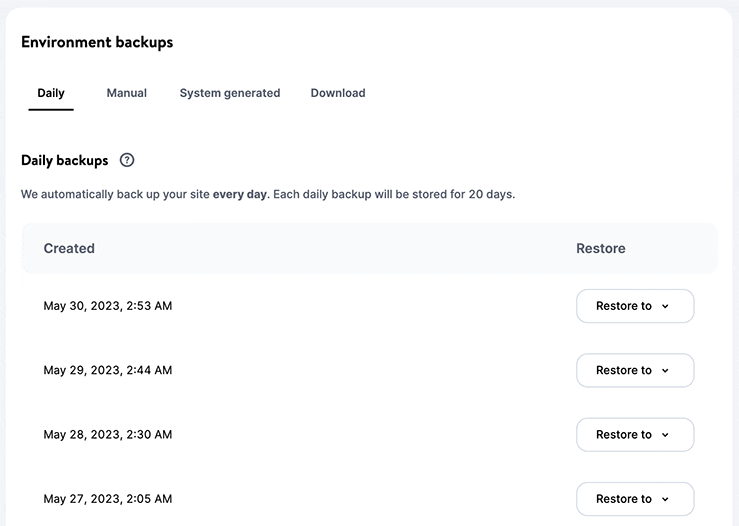
Article
8 Best Practices For WordPress Development
PUBLISHED:May 30, 2023
UPDATED:April 2, 2024
In the ever-evolving digital landscape, WordPress has emerged as one of the most popular content management systems (CMS) for building dynamic and feature-rich websites. With its user-friendly interface and extensive plugin ecosystem, WordPress offers developers a flexible platform to create stunning web experiences. However, in order to maximise the potential of this powerful CMS, adhering to best practices for WordPress development becomes crucial.
With its user-friendly interface and extensive plugin ecosystem, WordPress offers developers a flexible platform to create stunning web experiences. However, to maximize the potential of this powerful CMS, adhering to best practices for WordPress development becomes crucial.
Best practices encompass a set of guidelines and techniques that ensure efficient, secure, and scalable WordPress projects. These practices streamline the development process, enhance website performance, and maintain code readability, making them indispensable for developers.
They encompass various aspects, including coding standards, plugin and theme management, security measures, optimization techniques, and performance optimization.
This article explores the significance of adopting best practices for WordPress development and sheds light on their role in building robust and future-proof websites.
By following these practices, developers can not only deliver exceptional user experiences but also ensure long-term success, scalability, and maintainability for their WordPress projects.
Whether you’re a seasoned developer or a novice exploring WordPress development, embracing these best practices is vital to unlocking the full potential of this versatile CMS.
What is WordPress Website Development?
WordPress development refers to the process of creating and customizing websites using the WordPress content management system (CMS). WordPress provides a user-friendly interface and a wide range of themes, templates, and plugins, making it accessible even for individuals with limited technical expertise.
The benefits of using WordPress as a platform for building a website are manifold. Firstly, WordPress is highly customizable, allowing developers the ability to create unique and visually appealing websites tailored to specific needs.
Additionally, its extensive plugin ecosystem provides access to a vast array of features and functionalities, enabling the integration of e-commerce capabilities, social media integration, SEO optimization, and much more.
WordPress is renowned for its search engine friendliness, with built-in SEO features that aid in website visibility and ranking. It also boasts a responsive design system, ensuring optimal performance across different devices. Furthermore, WordPress is continuously updated, ensuring improved security, bug fixes, and enhanced functionality.
Overall, WordPress is a game-changer for website development. It simplifies the process, provides scalability and flexibility, and empowers developers to craft stunning, bespoke WordPress websites, themes, and plugins tailored to their client’s exact needs.
Why Use WordPress as a CMS?
Using WordPress as a CMS for bespoke website creation offers a range of core benefits.
- It’s user-friendly interface and intuitive dashboard make it accessible to individuals with varying technical expertise, enabling easy content management and updates.
- WordPress offers excellent scalability, allowing websites to grow and expand as needed. Using pre-defined page templates or content blocks to create new pages as required, adding them to the navigation menu where appropriate.
- It provides robust SEO features, optimising websites for search engines and improving online visibility via the Yoast Plugin.
- WordPress has a strong and active community of developers, ensuring constant updates, security patches, and support for themes and plugins.
- Lastly, WordPress is cost-effective, making it an ideal choice for businesses and individuals seeking high-quality, customisable websites without breaking the bank.
All of these benefits add up to a website platform that is suitable for creating a vast array of sites. From straightforward blogs and news platforms to more complex websites for estate agents and charities, the possibilities are endless.
WordPress is a robust platform, that when handled correctly, with best practices adhered to, would form the ideal foundation for any brand’s website.
8 WordPress Development Best Practices You Need To Know
1: Secure Your WordPress Site
Securing a WordPress site against attacks is of paramount importance in today’s digital landscape. With the increasing frequency and sophistication of cyber threats, taking proactive measures to protect your website is essential. The best way to do this is by implementing a multi-layered security approach.
- Start by keeping your WordPress core, themes, and plugins up to date to patch any vulnerabilities.
- Utilize strong, unique passwords and consider implementing two-factor authentication for added protection.
- Regularly back up your site to ensure you have a clean restore point in case of a security breach.
- Install a reputable security plugin that offers features such as malware scanning, firewall protection, and brute-force attack prevention.
Implementing a web application firewall (WAF) can add an extra layer of defence by filtering out malicious traffic. It’s crucial to choose a reliable hosting provider that prioritizes security and offers robust server-side protections.
Lastly, stay informed about the latest security practices and emerging threats. Regularly monitor your site for suspicious activity and promptly address any vulnerabilities. By adopting these best practices and remaining vigilant, you can significantly reduce the risk of security breaches and safeguard your WordPress site and its valuable data.
2: Optimize Website Speed
Website speed plays a crucial role in delivering an exceptional user experience. In today’s fast-paced digital world, users have little patience for slow-loading websites. A slow site can lead to increased bounce rates, decreased user engagement, and ultimately, lost opportunities for conversions and revenue.
Optimizing website speed is vital to provide users with a seamless browsing experience. One effective method is caching, which involves storing static versions of web pages to reduce server processing time and load the site faster.
Additionally, optimizing images by compressing and resizing them without compromising quality can significantly reduce page size and improve loading times.
Using a content delivery network (CDN) is another valuable technique. CDNs distribute website content across multiple servers globally, allowing users to access data from the nearest server, reducing latency and improving load times.
Other optimization methods include minimizing HTTP requests and optimizing code and scripts. Regular performance monitoring and testing are essential to identify and address bottlenecks that may affect website speed.
By prioritizing website speed and employing optimization techniques like caching, image optimization, and CDNs, businesses can enhance user experience, increase engagement, and achieve higher conversion rates, ultimately driving the success of their online presence.
3: Use Responsive Web Design
Responsive web design refers to the approach of creating websites that adapt and respond seamlessly to different screen sizes and devices, providing an optimal viewing and browsing experience for users.
It involves designing and coding websites to automatically adjust the layout, font sizes, images, and other elements based on the device being used, whether it’s a desktop, tablet, or mobile phone.
The importance of responsive web design for mobile optimization cannot be overstated. With the increasing use of smartphones and tablets for browsing the internet, having a mobile-friendly website is essential. Responsive design ensures that your website looks and functions flawlessly on any device, eliminating the need for separate mobile versions or multiple websites.
By adopting responsive web design, businesses can improve user experience, reduce bounce rates, and increase engagement and conversions. It also has significant SEO benefits, as search engines prioritize mobile-friendly websites in mobile search results.
In today’s mobile-driven world, responsive web design is a fundamental aspect of creating a successful online presence, allowing businesses to reach and engage their audience effectively across all devices.
Professional WordPress designers will employ a mobile-first design ethic ensuring that your website theme is fully responsive for mobile devices.
4: Implement SEO Best Practices
SEO (Search Engine Optimization) is crucial in WordPress development to improve website visibility and organic traffic. Implementing SEO best practices ensures that your WordPress site is optimized for search engines, increasing its chances of ranking higher in search results.
One way to optimize SEO is by utilizing meta tags. Adding relevant and descriptive meta titles and meta descriptions to each page helps search engines understand the content and improves click-through rates. Optimizing content with targeted keywords, headings, and well-structured URLs also enhances SEO.
In WordPress, optimizing images involves reducing file sizes, adding alt text with relevant keywords, and using descriptive filenames. This improves page load times and helps search engines understand the context of the images.
Monitoring analytics data is essential to track website performance, user behaviour, and keyword rankings. Tools like Google Analytics provide valuable insights to identify areas for improvement and adjust SEO strategies accordingly.
Furthermore, focusing on quality content creation, interlinking relevant pages, optimizing site speed, and ensuring mobile responsiveness are additional SEO best practices.
By implementing these SEO techniques, WordPress developers can enhance the visibility, credibility, and organic reach of their websites, driving increased traffic and achieving better overall performance in search engine rankings.
5: Optimize User Experience
A good user experience (UX) refers to the overall satisfaction and ease of use that a user experiences when interacting with a website or application. It encompasses factors such as intuitive navigation, fast loading times, visually appealing design, clear and concise content, and seamless functionality.
To optimize user experience, clear navigation is essential. Users should be able to easily find what they’re looking for through well-organized menus and intuitive user interfaces. Additionally, using easy-to-read content with a logical structure and formatting enhances readability and comprehension.
A minimalist design approach focuses on simplicity and decluttering, ensuring that the interface is visually pleasing and distractions are minimized. It promotes a clean and uncluttered layout, allowing users to focus on the most important elements and tasks.
Other ways to optimize UX include
- Responsive design for seamless browsing across devices
- Providing clear calls-to-action
- Offering personalized and relevant content
- Optimizing website speed for fast and efficient performance.
By prioritizing these aspects, developers can create a user-centric experience that not only engages and satisfies users but also encourages them to stay longer, return, and convert, ultimately contributing to the success of the website or application.
6: Implement Regular Backups
Regular backups are crucial in WordPress development to protect against data loss, security breaches, or website failures. Backing up your WordPress site ensures that you have a recent copy of all your files, content, and configurations, allowing for quick recovery in case of any unforeseen events.
Implementing a regular backup schedule is essential. One way is to utilize backup plugins specifically designed for WordPress.
These plugins offer automated backup options, allowing you to schedule regular backups at convenient intervals. They also provide flexibility in choosing what to include in the backup, such as files, databases, or both.
Storing backups in multiple locations is another best practice. Consider storing backups on external servers, cloud storage, or offline storage mediums like external hard drives. This ensures redundancy and protects against any single point of failure.
Regularly testing the backups is equally important to verify their integrity and restoration process. This practice helps identify any potential issues and ensures the backups are viable when needed.
By implementing a regular backup schedule using plugins and storing backups in multiple locations, developers can safeguard their WordPress websites and have peace of mind knowing they can restore their sites quickly and efficiently in case of any unfortunate incidents.
7: Follow WordPress Coding Standards
WordPress PHP coding standards are a set of guidelines and conventions that ensure consistency and readability in the codebase of WordPress themes, plugins, and core development. Adhering to these standards is crucial for several reasons.
Firstly, it promotes code maintainability, making it easier for developers to understand and collaborate on projects. Secondly, it enhances code quality, reducing the likelihood of bugs and errors. Moreover, following WordPress coding standards ensures compatibility with future WordPress updates and compatibility with other themes and plugins.
To follow WordPress coding standards, developers should adhere to the WordPress coding conventions, which cover aspects like naming conventions, indentation, comments, and file organization. It is also essential to follow web server configuration rules recommended by WordPress for optimal performance and security. Validating code using tools like PHP_CodeSniffer helps ensure compliance and identifies any deviations from the standards.
By embracing WordPress PHP coding standards, developers contribute to the overall stability, maintainability, and compatibility of the WordPress ecosystem, providing a better user experience and facilitating collaboration within the WordPress community.
8: Develop the Right WordPress Plugins
WordPress plugin development involves creating software modules that extend the functionality of a WordPress website. Plugins enable developers to add custom features, modify existing functionality, or integrate third-party services seamlessly. Following best practices in custom plugin development is essential for creating high-quality and maintainable plugins.
Using WordPress API functions is a key practice as it ensures compatibility with WordPress core and other plugins. It provides standardized ways to interact with WordPress, enhancing stability and reducing conflicts. Adhering to the right coding conventions, such as following the WordPress coding standards, ensures consistency, readability, and compatibility across different environments.
Thoroughly testing plugins for compatibility with various WordPress versions, themes, and other popular plugins is crucial. It helps identify and resolve conflicts or issues, ensuring a smooth user experience. Regular updates and support are also important for keeping the plugin secure, optimized, and compatible with the evolving WordPress ecosystem.
It’s easy for anyone to install WordPress on a server, add a theme and then install some plugins, but there is no guarantee that all of these elements will work together as required.
Experts in bespoke WordPress development will create plugins that are tailored to your needs and work seamlessly with your website, resulting in a faster and more secure platform.
WordPress Development Best Practices: Closing Thoughts
Following best practices when building a website using WordPress is important to ensure that your website performs as best as it can for your users, your team and for search engines.
As a reminder, our list of the top 8 Best Practices For WordPress Development are:
- Secure Your WordPress Site with hard-to-guess passwords, security plugins and by keeping your WordPress theme and plugins updated regularly.
- Optimize Website Speed by using clean & concise code, reducing image file sizes and using a CDN.
- Use Responsive WordPress Themes & Web Design to ensure that your website is viewable on mobile devices.
- Implement SEO Best Practices by injecting your target keywords into page URLs, page titles, meta descriptions and image alt tags.
- Optimize the User Experience by carefully designing the pages so that the user can easily find CTAs and making sure that the pages load fast during their journey.
- Implement Regular Backups using external drives, plugins or backup solutions provided by your hosting company.
- Follow WordPress Coding Standards by adhering to WordPress coding conventions, including naming conventions, indentation, comments, and file organization.
- Develop the Right WordPress Plugins – Only use the best 3rd-party plugins that have been carefully vetted and are regularly updated, and where possible, write your own plugins to make sure that your website is as secure as possible.
Implementing these best practices in WordPress development is vital for creating a website that is secure, optimized, and user-friendly. They ensure protection against vulnerabilities, enhance performance, improve user experience, and establish a solid foundation for long-term success.
LWDA are experts in WordPress Development. Our WordPress Developer teams have spent years honing their skills, following only the best practices when building websites for our valued clients.
Ready to take your WordPress development to the next level? Get in touch and we’ll be happy to discuss your requirements.




